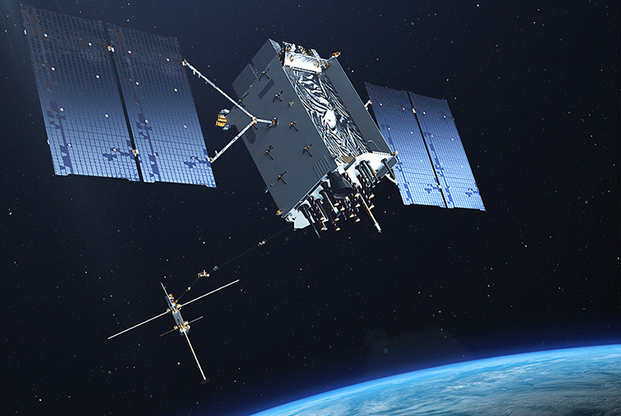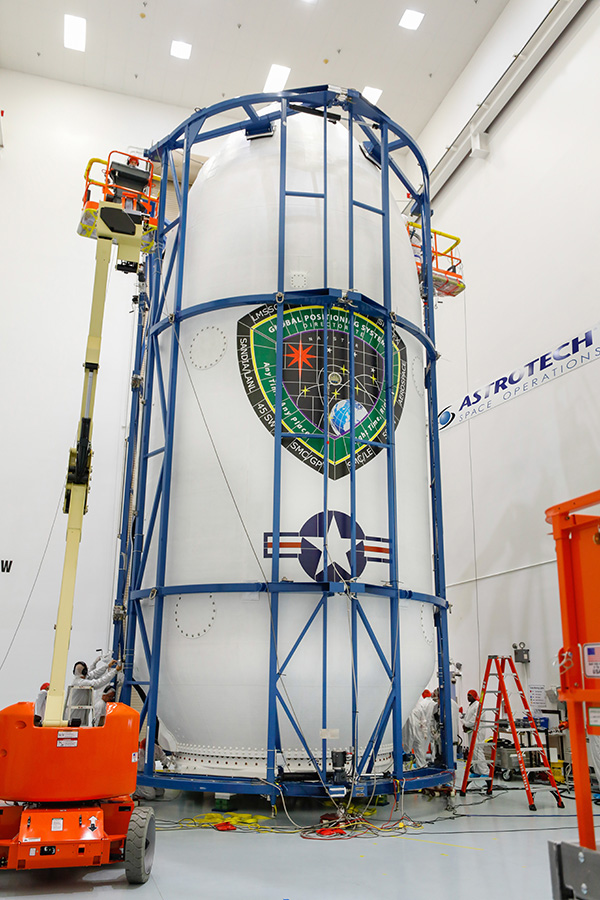
Artistic rendering of the Lockheed Martin-build GPS III satellite. Lockheed Martin image.
The Air Force and its industry partners are ready for the Dec. 18 launch of the first GPS III satellite aboard a SpaceX Falcon 9 rocket, officials told reporters on Friday.
The historic mission will not only be the first of the next-generation navigational satellites on orbit, it also marks the first National Security Space mission aboard a SpaceX Falcon 9 rocket, and the first satellite to do launch and control checkout with the service’s new ground control system, known as OCX Block Zero, which was delivered to the Air Force in November 2017 after a years-long delay.
Vice President Mike Pence announced via Twitter on Dec. 12 that he would head to Cape Canaveral AFS, Fla., to watch the launch, calling it “an important step forward as we seek to secure American leadership in space.”
GPS III satellites are three times more accurate and up to eight times more powerful than the 31 existing satellites in the GPS constellation, said Col. Steve Whitney, director of the Space and Missile Systems Center’s Global Positioning Systems Directorate, in the teleconference with reporters. The first GPS III satellite vehicle, nicknamed “Vespucci” in honor of Amerigo Vespucci, the Italian explorer for whom the Americas were named, will eventually replace SVM43, launched in July 1997.

USAF’s first Lockheed Martin-built GPS III satellite is encapsulated within a SpaceX Falcon 9 payload on Dec. 7 in preparation for its upcoming launch from Cape Canaveral Air Force Station, Fla. SpaceX courtesy photo
Lee Rosen, SpaceX’s vice president of customer operations and integration, said the launch window begins at 9:11 p.m. and is open for 26 minutes. Unlike other SpaceX launches, the company will not try t?o land its booster, though officials did not rule out reusable boosters for future GPS launches.
“For this first flight, we’re going through making sure we’re taking care of the spacecraft … Everything we do, we’re making sure we treat it safely,” said Walter Lauderdale, mission director of SMC’s launch enterprise systems directorate. After launch, he said USAF, Lockheed Martin, and SpaceX will “come back together as a team and look for opportunities to see if we can get performance back that will enable SpaceX to recover their vehicle.”
GPS III also will provide the military with M-Code capability—a stronger signal that is more resistant to jamming and spoofing.
Raytheon, the OCX prime contractor, was originally slated to deliver early use M-Code capability by February 2015, but a long series of delays and cost overruns led to a Nunn-McCurdy breach of the entire OCX program in July 2016. Last year, SMC awarded Lockheed a $45 million contract to upgrade legacy control systems so the Air Force can operate the new satellites before that time. Whitney said he anticipates OCX Block 1, which would enable M-Code capability, to be delivered in the 2021-2022 timeframe.
Once launched, it could take as long as six to nine months to check out the satellite on orbit and then another six to nine months to integrate the GPS III satellite with the rest of the constellation, officials said.
